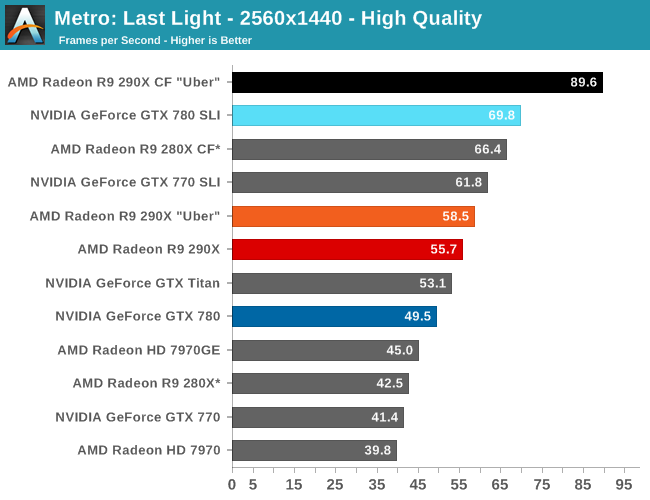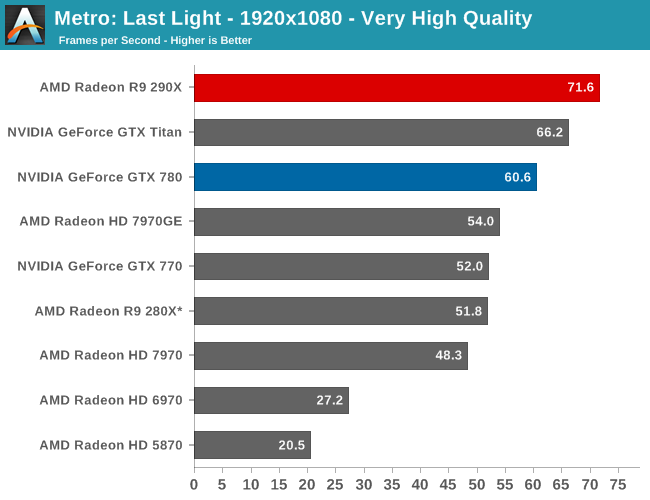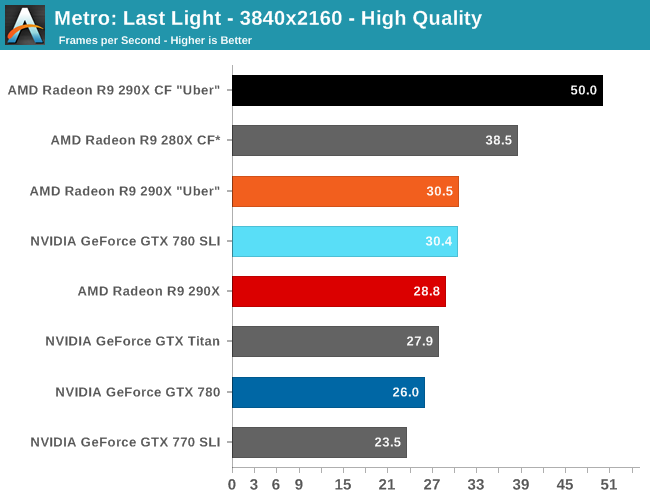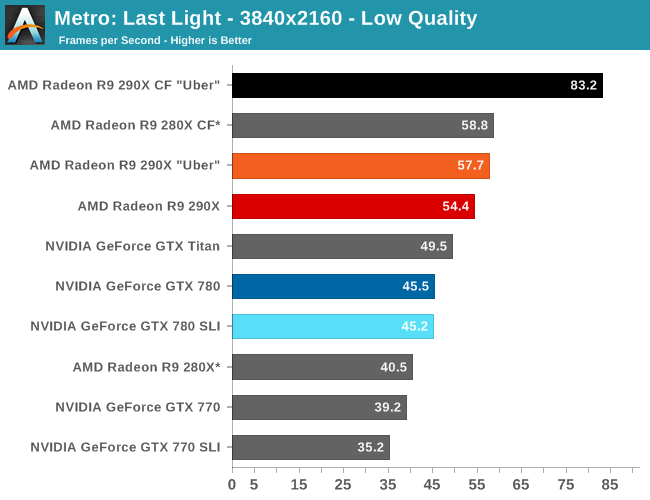The AMD Radeon R9 290X Review
by Ryan Smith on October 24, 2013 12:01 AM EST- Posted in
- GPUs
- AMD
- Radeon
- Hawaii
- Radeon 200
Metro: Last Light
As always, kicking off our look at performance is 4A Games’ latest entry in their Metro series of subterranean shooters, Metro: Last Light. The original Metro: 2033 was a graphically punishing game for its time and Metro: Last Light is in its own right too. On the other hand it scales well with resolution and quality settings, so it’s still playable on lower end hardware.


For the bulk of our analysis we’re going to be focusing on our 2560x1440 results, as monitors at this resolution will be what we expect the 290X to be primarily used with. A single 290X may have the horsepower to drive 4K in at least some situations, but given the current costs of 4K monitors that’s going to be a much different usage scenario.
With that said, for focusing on 4K on most games we’ve thrown in results both at a high quality setting, and a lower quality setting that makes it practical to run at 4K off of a single card. Given current monitor prices it won’t make a ton of sense to try to go with reduced quality settings just to save $550 – and consequently we may not keep the lower quality benchmarks around for future articles – but for the purposes of looking at a new GPU it’s useful to be able to look at single-GPU performance at framerates that are actually playable.
With that said, starting off with Metro at 2560 the 290X hits the ground running on our first benchmark. At 55fps it’s just a bit shy of hitting that 60fps average we love to cling to, but among all of our single-GPU cards it is the fastest, beating even the traditional powerhouse that is GTX Titan. Consequently the performance difference between 290X and GTX 780 (290X’s real competition) is even greater, with the 290X outpacing the GTX 780 by 13%, all the while being $100 cheaper. As we’ll see these results are a bit better than the overall average, but all told we’re not too far off. For as fast as GTX 780 is, 290X is going to be appreciably (if not significantly) faster.
290X also does well for itself compared to the Tahiti based 280X. At 2560 the 290X’s performance advantage stands at 31%, which as we alluded to earlier is greater than the increase in die size, offering solid proof that AMD has improved their performance per mm2 of silicon despite the fact that they’re still on the same 28nm manufacturing process. That 31% does come at a price increase of 83% however, which although normal for this price segment serves as a reminder that the performance increases offered by the fastest video cards with the biggest GPUs do not come cheaply.
Meanwhile for one final AMD comparison, let’s quickly look at the 290X in uber mode. As the 290X is unable to sustain the power/heat workload of a 1000MHz Hawaii GPU for an extended period of time, at its stock (quiet settings) it has to pull back on performance in order to meet reasonable operational parameters. Uber mode on the other hand represents what 290X and the Hawaii can do when fully unleashed; the noise costs won’t be pretty (as we’ll see), but in the process it builds on 290X’s existing leads and increases them by another 5%. And that’s really going to be one of the central narratives for 290X once semi-custom and fully-custom cards come online: Despite being a fully enabled part, 290X does not give us everything Hawaii is truly capable of.


Moving on, let’s talk about multi-GPU setups and 4K. Metro is a solid reminder that not every game scales similarly across different GPUs, and for that matter that not every game is going to significantly benefit from multi-GPU setups. Metro for its part isn’t particularly hospitable to multi-GPU cards, with the best setup scaling by only 53% at 2560. This is better than some games that won’t scale at all, but it won’t be as good as those games that see a near-100% performance improvement. Which consequently is also why we dropped Metro as a power benchmark, as this level of scaling is a poor showcase for the power/temp/noise characteristics of a pair of video cards under full load.
The real story here of course is that it’s another strong showing for AMD at both 2560 and 4K. At 2560 the 290X CF sees better performance scaling than the GTX 780 SLI – 53% versus 41% – further extending the 290X’s lead. Bumping the resolution up to 4K makes things even more lopsided in AMD’s favor, as at this point the NVIDIA cards essentially fail to scale (picking up just 17%) while the 290X sees an even greater scaling factor of 63%. As such for those few who can afford to seriously chase 4K gaming, the 290X is the only viable option in this scenario. And at 50fps average for 4K at high quality, 4K gaming at reasonable (though not maximum) quality settings is in fact attainable when it comes to Metro.
Meanwhile for single-GPU configurations at 4K, 4K is viable, but only at Metro’s lowest quality levels. This will be the first of many games where such a thing is possible, and the first of many games where going up to 4K in this manner further improves on AMD’s lead at 4K. Again, we’re not of the opinion that 4K at these low quality settings is a good way to play games, but it does provide some insight and validationg into AMD’s claims that their hardware is better suited for 4K gaming.










396 Comments
View All Comments
Deaks2 - Thursday, October 24, 2013 - link
Hi Ryan,While I can appreciate the hard work put into the review, just putting up the charts without the explainer pieces is confusing. I had to read HardOCP's review to know what Uber was, your section on Powertune was a work in progress. Also, reading the temperature information was shocking, until, again, I read the relevant section of the HardOCP review and learned that the cards will operate at 95 deg C in order to reduce fan noise.
Also, a comparison to the 7990, the current single-slot performance king, would have been useful, since the R9 290x and 7990 are currently priced similarly. Thankfully, TechSpot included the 7990 and various 7970 and 7950 CF configurations in their review.
As usual, I came to this site first to read the review, but had to go elsewhere to get the context to the charts that you presented.
Thanks!
BryanC - Thursday, October 24, 2013 - link
Actually, I value your commentary more than the charts, which to be honest are similar to the other charts out there. =)anubis44 - Thursday, October 24, 2013 - link
Oh, I'm here for the crafty journalism and the witty banter in the discussion thread :)Seriously, thanks for going the extra mile with the crossfire and FCAT data, Ryan. Much appreciated. Any word on custom cards and the R9 290 (as opposed to the 290X) would also be greatly appreciated. The R9 290 may be my next card.
jeremynsl - Thursday, October 24, 2013 - link
I don't mean to rag on you guys (up late working and all), but it is unprofessional to post unfinished reviews like this. Full stop.I know you have made commitments to hit embargo dates, but is it really worth compromising article quality to this degree? I mean, even if only 10% of readers see it in the unfinished state it's pretty bad. I would not be ok with this, if it was my site and/or my writing.
ZeDestructor - Thursday, October 24, 2013 - link
Like quite a few other people, I would rather read the technical breakdown rather than the benchmark results. If I only cared about benchmark results, I would go around compiling results from several sites to account for configuration differences.It really boils down to preferring a complete review over a performance review. For performance there's the bench tool already, which is far more useful since I can filter out all the irrelevant results
Ryan Smith - Monday, October 28, 2013 - link
Hi guys;Your comments have been heard, so please don't think they're falling on deaf ears.
Frankly we're no more happy about this than the rest of you are, which is why we try to avoid something like this if at all possible. But in this case we can't do a meaningful write-up without the benchmark data, so there's really no getting around it in this case.
The final article ended up being a hair over 22K words. That would normally be a week-long writing job, never mind the benchmarking (new GPU + CF). So I hope if nothing else the belatedly complete article is up to your standards as our readers.
Black Obsidian - Tuesday, October 29, 2013 - link
I would definitely agree that the complete article is up to the standards I've come to expect from Anandtech.But I would also much prefer to wait an extra day or two for the complete article, rather than get the "fill in the blanks" that the 290X review started out as. I come to Anandtech for the in-depth analysis; if that's not available when I click on the article in the first place, I'm less inclined to even bother.
Stuka87 - Thursday, October 24, 2013 - link
Incredible bang for the buck card. $550 is a chunk of money yes, but compared to the competition its a steal!tential - Thursday, October 24, 2013 - link
Jumped to Final Words and it's a work in Progress...That's my favorite part and it's the one I real first!!!!
nooooo.
Elixer - Thursday, October 24, 2013 - link
Looks like nice card...No wonder the green team got their panties in a bind.